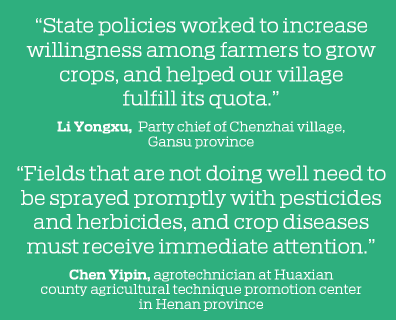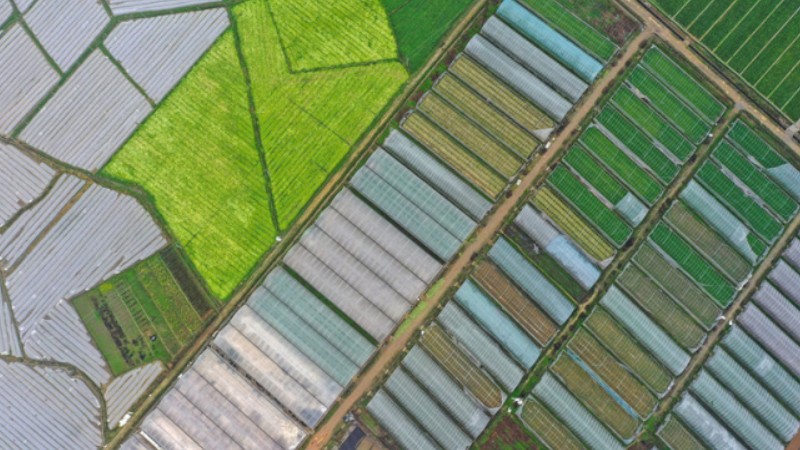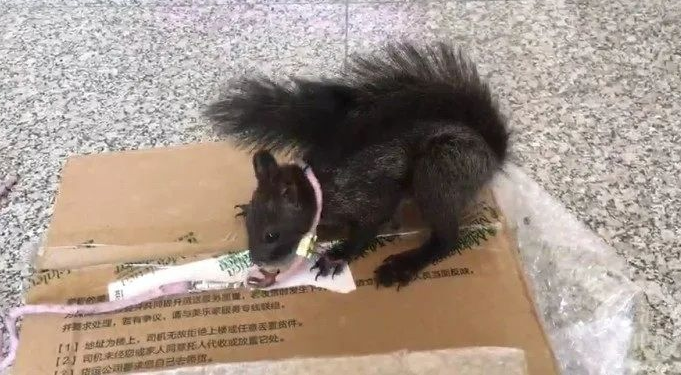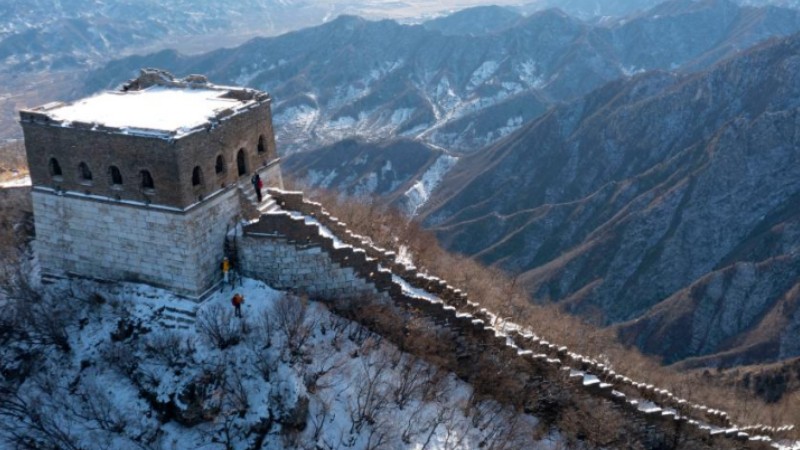Spring plowing boosted by State measures

WU HEPING/FOR CHINA DAILY
Despite the weather being bitterly cold in Gansu province before Chinese New Year last month, Li Yongxu, Party chief of a village that grows vegetables, wished he could halt the approach of spring, when annual food production in the area begins.
Local authorities placed a grain-growing quota of 540 hectares on his village, Chenzhai, which has a population of about 2,500.
Meeting this quota — largely similar to those set in the past — should not have been a problem this year, but a surge in COVID-19 infections since December raised uncertainties over spring plowing, which starts on Monday.
Following the introduction of optimized COVID-19 regulations nationwide, outbreaks of the disease fueled by the Omicron variant, which had struck cities such as Beijing and Shanghai, spread to rural regions as millions of migrant workers traveled home for Spring Festival family reunions.
As in cities, rising infections in rural areas temporarily reduced the ranks of active agrotechnicians, workers in fertilizer factories, and truck drivers — fueling surging labor costs that worried Li and his fellow village officials.
These officials need to meet such quotas as part of the Communist Party of China's efforts to safeguard national food security in a sweeping drive aimed at putting the task of feeding the nation firmly in the hands of the Chinese people.
"I feared we could miss the target this year," Li said.
The fallout from the labor shortage, coupled with costlier raw materials globally, quickly triggered higher prices not only for fertilizers, but almost all aspects of farming, including transportation, electricity and irrigation.
Speaking at a spring plowing meeting on Feb 6, Tang Renjian, director of the Central Rural Work Leading Group Office and minister of agriculture and rural affairs, said production was generally faring well, although challenges had emerged such as rising production costs due to surging fertilizer prices. He urged officials to transport agricultural materials such as fertilizers well in advance and launch a crackdown on fake or faulty products.
Li feared that inflation would result in profitless grain production this year, in turn driving farmers from fields and leaving State-designated targets hard to reach.
However, such a scenario never materialized.
"State policies worked to increase willingness among farmers to grow crops, and helped our village fulfill its quota," Li said, referring to an agricultural subsidy given to farmers when the market underperforms.
Villagers will now head to the fields to plant vegetables, and Li expects to harvest about 7,500 metric tons of crops in May. Farmers will also plant corn in April, which he said will result in a harvest of about 4,000 tons.
The labor shortage was also felt in Guangxi Zhuang autonomous region.
Zhang Yunqin, who works at a rail freight station in Fangchenggang, home to a fertilizer manufacturer serving several grain-growing cities in neighboring Hunan province, said the shortage of hands was a major problem this year for the station to ensure that fertilizers reached fields on time.
Spring Festival fell on Jan 22 this year, a peak season for fertilizer transportation.
"The number of porters at our station dropped from 40 to just 10 after many returned home for Chinese New Year," Zhang said.
Due to COVID-19 travel restrictions, many workers had not gone home for Spring Festival for the past three years, but Zhang said 24 employees returned to the freight station this month.
To prevent delays in fertilizers reaching their destination stations, Gan Xiaohua, an official at Fangchenggang station, said overtime was worked and the scheduling of cargo trains transporting important farming materials improved.
Destination stations were also contacted in advance to allocate space for incoming fertilizer, thus reducing waiting times, she said.
According to management at the station, some 130,000 tons of fertilizer left Fangchenggang by Feb 6, including 1,300 tons shipped during the weeklong Spring Festival holiday.
The annual spring farming season starts from February to May nationwide from the south to north of China.
It has long been viewed as the most important plowing season, because the grain that farmers plant, and the action taken to care for crops, significantly affects grain output in summer and autumn, and also the price of food throughout the year.
These significant factors are best summed up in the Chinese expression "Don't miss farming time".
Spring plowing has taken on added importance as China seeks to expand the planting areas for oil crops such as soybeans and rapeseed, which are sowed at this time.
Solid foundation
Speaking at a conference on Jan 28, Premier Li Keqiang said spring crops contribute about 60 percent of the nation's annual grain output. Crops planted earlier but requiring intervention in spring account for 40 percent of staple food output.
Li urged officials to step up preparations for the farming season, not to miss planting time, and lay a solid foundation for the central government's efforts to bolster food supply and stabilize prices this year.
He stressed the need for food production quotas to be decided quickly and for stable areas to grow soybeans, which tend to be excluded in favor of crops that are more lucrative.
Li emphasized the government's support for farmers, such as helping them transfer agricultural equipment across regions, and buying fertilizers and seeds for them.
He said local authorities must ensure grain purchasing prices do not drop below a benchmark level, which is adjusted annually, and that subsidies are handed out to farmers who grow grain.
Expansion appeal
On Feb 6, Tang, the agriculture minister, encouraged officials to make every effort to expand areas to grow soybeans.
He said efforts must be made to sustain such areas through technological innovation and incentives, or by promoting food processing to increase the profit from crops.
Tang asked government departments to speed up the introduction of more detailed policies to subsidize soybean growers and counties in which these crops are produced. He also called for insurance cover to be expanded in pilot zones to reduce risk from growing soybeans, and for the price gap between soybeans and corn to be narrowed.
He added that local authorities must explore methods such as intercropping with corn to bolster soybean production, and help farmers solve problems relating to farming equipment and techniques.
Intercropping involves planting or growing more than one crop at a time on the same piece of land, as these crops are not likely to share insects and disease-causing agents. The goal is to produce a greater yield than if the space was used for a single crop.
Tang also urged local authorities to strengthen management of fields, increase food productivity, and secure a bumper harvest of crops such as wheat, soybeans and rapeseed in summer.
Li, the village Party chief, said the local government sent a team of experts to instruct farmers in planting vegetables and corn to avoid unnecessary damage to the crops.
"The authorities also publicized our farm produce and placed orders for it," he added.
In Henan province, a key area for winter wheat, agrotechnicians visited fields to manage the crop.
Wheat seedlings have been affected by lower temperatures than usual and a shortage of rainfall.
Huaxian county, a major wheat producing area in the north of the province with 130,000 hectares of farmland, has witnessed such problems.
Chen Yipin, an agrotechnician at the county's agricultural technique promotion center, said local wheat is still "overwintering" and field management work must wait.
However, more than 100 agrotechnicians have started to inspect wheatfields for signs of drought and disease to help farmers take remedial action later.
"Fields that are not doing well need to be sprayed promptly with pesticides and herbicides, and crop diseases must receive immediate attention," he said.
Vaccinations boosted
Observers feared that outbreaks of COVID-19 fueled by the Omicron variant in recent months could delay spring plowing this year to a disastrous extent.
When the disease put a strain on urban hospitals in December, authorities bolstered vaccination against it and sent crucial medical supplies to rural areas with a low level of such resources.
Relief measures ranged from providing rural health clinics with oximeters and drugs to reduce fever to supplying beds for critical care patients and breathing equipment at county hospitals.
In addition to supplying badly needed equipment for patients in villages, authorities worked to prevent residents from contracting COVID-19.
Villagers were asked to streamline celebratory banquets during the Spring Festival holiday. Neighborhood officials, Party members and volunteers were called in to look after the most vulnerable residents, including so-called left-behind seniors and young children, whose parents only return briefly from jobs in cities during the Spring Festival.
Wu Hongyao, deputy director of the Office of the Central Rural Work Leading Group and a senior Party official at the Ministry of Agriculture and Rural Affairs, said on Feb 3 that the Spring Festival holiday, which ended on Jan 27, had not caused a rise in COVID-19 cases in rural areas as expected.
Citing local figures, he said new infections in the countryside dropped steadily despite a rising number of gatherings and the mass movement of migrant workers returning home for family reunions.
This was a relief to many people with relatives in areas where medical resources are stretched thin.
Wu urged local authorities to ensure the pandemic does not affect the plowing season.
Qi Xin contributed to this story.

Photos
Related Stories
- Spring ploughing and seedling raising start in SW China's Guizhou
- Grape growing sweetens villagers' life, builds careers for "new farmers"
- China makes progress in development of "plant factories"
- Spring rain refreshes fields in C China’s Hunan
- Chinese farmers hit per capita income milestone
- China sends fresh signals on advancing rural revitalization, building agricultural strength
- Agricultural Bank of China ups support for spring farming
- Two Chinese Gen Zers turn to agriculture in E China’s Anhui
- China's agricultural insurance premiums surge 23 pct in 2022
- China's agricultural product prices up in January
Copyright © 2023 People's Daily Online. All Rights Reserved.









